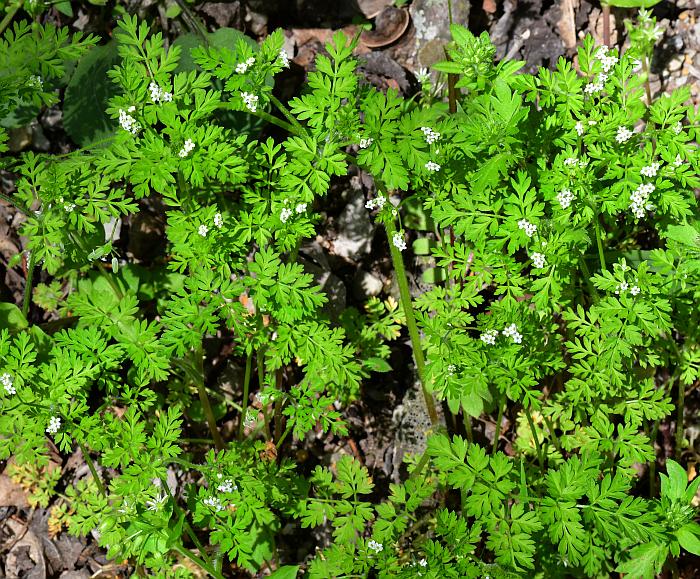Chaerophyllum procumbens (L.) Crantz
Wild Chervil

Native
CC = 2
CW = -3
MOC = 79
© SRTurner
Chaerophyllum procumbens (L.) CrantzWild Chervil | |
 |
Native CC = 2 CW = -3 MOC = 79 |
© SRTurner |
|
Family - Apiaceae Habit - Annual forb. Stem - Spreading to loosely ascending, 10-60 cm, glabrous or sparsely hairy toward the base, sometimes also at the nodes, usually hairy above. Leaves - Alternate and usually basal, short- to long-petiolate, the uppermost leaves sometimes nearly sessile, the sheathing bases not or only slightly inflated. Blades broadly ovate to oblong-ovate in outline, pinnately or ternately then pinnately 3 times compound, 1-12 cm long, glabrous or the undersurface sparsely hairy along the veins, the ultimate segments entire to few-toothed or deeply pinnately lobed or dissected, the leaflets or lobes linear to narrowly obovate, mostly narrowed at the base, rounded or narrowed to a blunt or sharp point at the tip, 1-8 mm long, 1-4 mm wide.
Inflorescences - Terminal and axillary, compound or sometimes simple umbels, short-to long-stalked or often sessile. Involucel of 4-6 bractlets, these mostly longer than the flower stalks but often shorter than the fruit stalks, usually fused together at the very base, elliptic-ovate to oblong-obovate, usually hairy along the margins. Rays 0.3-1.5 cm long at flowering, elongating to 5.5 cm at fruiting. Flowers 2-6 in each umbellet, sessile or the stalks to 2 mm long at flowering, these elongating unequally to 11 mm as the fruits develop, the fruit stalks uniformly linear, slender.
Flowers - Sepals absent. Petals obovate, rounded or shallowly notched at the tip, white. Ovaries glabrous or hairy.
Fruits - Schizocarps 5-10 mm long, linear to narrowly oblong-elliptic in outline, rounded or narrowed at the base, narrowed or short-tapered at the tip, flattened laterally, glabrous or hairy, brown to dark brown with usually lighter ribs, the mericarps sometimes somewhat arched or curved, sometimes somewhat narrowed along the commissures, with 5 narrow to broad, low, blunt ribs, these lacking wings.
Flowering - March - May. Habitat - Bottomland and mesic forests, streambanks, bluffs, glade margins, pastures, fields, fencerows, railroads, roadsides, yards, moist, disturbed areas. Origin - Native to the U.S. Lookalikes - C. tainturieri. Foliage resembles that of some ferns, most notably species of Cystopteris, as well as numerous other species. Other info. - This delicate and generally inconspicuous species is fairly common in Missouri, being found more or less statewide. Beyond Missouri it ranges throughout much of the upper Midwest and into New England. The plant is recognized by its fernlike leaves and tiny white flowers. It resembles its sibling C. tainturieri so closely that differentiation is difficult. C. procumbens is characterized by lower stems which are sparsely hairy at most, and by having fruit stalks which are uniformly slender rather than being flared at the tip. The fruits can be hairy or glabrous, and this attribute has been employed to name varieties. Photographs taken at the Dr. Frederick Marshall Conservation Area, Platte County, MO., 5-6-01 (DETenaglia); also along the Katy Trail near Marthasville, Warren County, MO, 5-9-2020, and along the Katy Trail near Treloar, Warren County, MO, 4-9-2021 (SRTurner). |